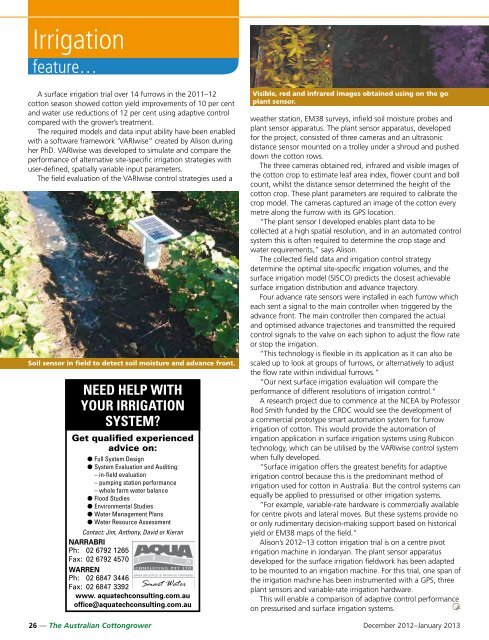cotton - Greenmount Press
cotton - Greenmount Press
cotton - Greenmount Press
You also want an ePaper? Increase the reach of your titles
YUMPU automatically turns print PDFs into web optimized ePapers that Google loves.
Irrigation<br />
feature…<br />
A surface irrigation trial over 14 furrows in the 2011–12<br />
<strong>cotton</strong> season showed <strong>cotton</strong> yield improvements of 10 per cent<br />
and water use reductions of 12 per cent using adaptive control<br />
compared with the grower’s treatment.<br />
The required models and data input ability have been enabled<br />
with a software framework ‘VARIwise” created by Alison during<br />
her PhD. VARIwise was developed to simulate and compare the<br />
performance of alternative site-specific irrigation strategies with<br />
user-defined, spatially variable input parameters.<br />
The field evaluation of the VARIwise control strategies used a<br />
Soil sensor in field to detect soil moisture and advance front.<br />
NEED HELP WITH<br />
YOUR IRRIGATION<br />
SYSTEM<br />
Get qualified experienced<br />
advice on:<br />
l Full System Design<br />
l System Evaluation and Auditing:<br />
– in-field evaluation<br />
– pumping station performance<br />
– whole farm water balance<br />
l Flood Studies<br />
l Environmental Studies<br />
l Water Management Plans<br />
l Water Resource Assessment<br />
Contact: Jim, Anthony, David or Kieran<br />
NARRABRI<br />
Ph: 02 6792 1265<br />
Fax: 02 6792 4570<br />
WARREN<br />
Ph: 02 6847 3446<br />
Fax: 02 6847 3392<br />
www. aquatechconsulting.com.au<br />
office@aquatechconsulting.com.au<br />
Visible, red and infrared images obtained using on -the-go<br />
plant sensor.<br />
weather station, EM38 surveys, infield soil moisture probes and<br />
plant sensor apparatus. The plant sensor apparatus, developed<br />
for the project, consisted of three cameras and an ultrasonic<br />
distance sensor mounted on a trolley under a shroud and pushed<br />
down the <strong>cotton</strong> rows.<br />
The three cameras obtained red, infrared and visible images of<br />
the <strong>cotton</strong> crop to estimate leaf area index, flower count and boll<br />
count, whilst the distance sensor determined the height of the<br />
<strong>cotton</strong> crop. These plant parameters are required to calibrate the<br />
crop model. The cameras captured an image of the <strong>cotton</strong> every<br />
metre along the furrow with its GPS location.<br />
“The plant sensor I developed enables plant data to be<br />
collected at a high spatial resolution, and in an automated control<br />
system this is often required to determine the crop stage and<br />
water requirements,” says Alison.<br />
The collected field data and irrigation control strategy<br />
determine the optimal site-specific irrigation volumes, and the<br />
surface irrigation model (SISCO) predicts the closest achievable<br />
surface irrigation distribution and advance trajectory.<br />
Four advance rate sensors were installed in each furrow which<br />
each sent a signal to the main controller when triggered by the<br />
advance front. The main controller then compared the actual<br />
and optimised advance trajectories and transmitted the required<br />
control signals to the valve on each siphon to adjust the flow rate<br />
or stop the irrigation.<br />
“This technology is flexible in its application as it can also be<br />
scaled up to look at groups of furrows, or alternatively to adjust<br />
the flow rate within individual furrows.”<br />
“Our next surface irrigation evaluation will compare the<br />
performance of different resolutions of irrigation control.”<br />
A research project due to commence at the NCEA by Professor<br />
Rod Smith funded by the CRDC would see the development of<br />
a commercial prototype smart automation system for furrow<br />
irrigation of <strong>cotton</strong>. This would provide the automation of<br />
irrigation application in surface irrigation systems using Rubicon<br />
technology, which can be utilised by the VARIwise control system<br />
when fully developed.<br />
“Surface irrigation offers the greatest benefits for adaptive<br />
irrigation control because this is the predominant method of<br />
irrigation used for <strong>cotton</strong> in Australia. But the control systems can<br />
equally be applied to pressurised or other irrigation systems.<br />
“For example, variable-rate hardware is commercially available<br />
for centre pivots and lateral moves. But these systems provide no<br />
or only rudimentary decision-making support based on historical<br />
yield or EM38 maps of the field.”<br />
Alison’s 2012–13 <strong>cotton</strong> irrigation trial is on a centre pivot<br />
irrigation machine in Jondaryan. The plant sensor apparatus<br />
developed for the surface irrigation fieldwork has been adapted<br />
to be mounted to an irrigation machine. For this trial, one span of<br />
the irrigation machine has been instrumented with a GPS, three<br />
plant sensors and variable-rate irrigation hardware.<br />
This will enable a comparison of adaptive control performance<br />
on pressurised and surface irrigation systems.<br />
26 — The Australian Cottongrower December 2012–January 2013

















